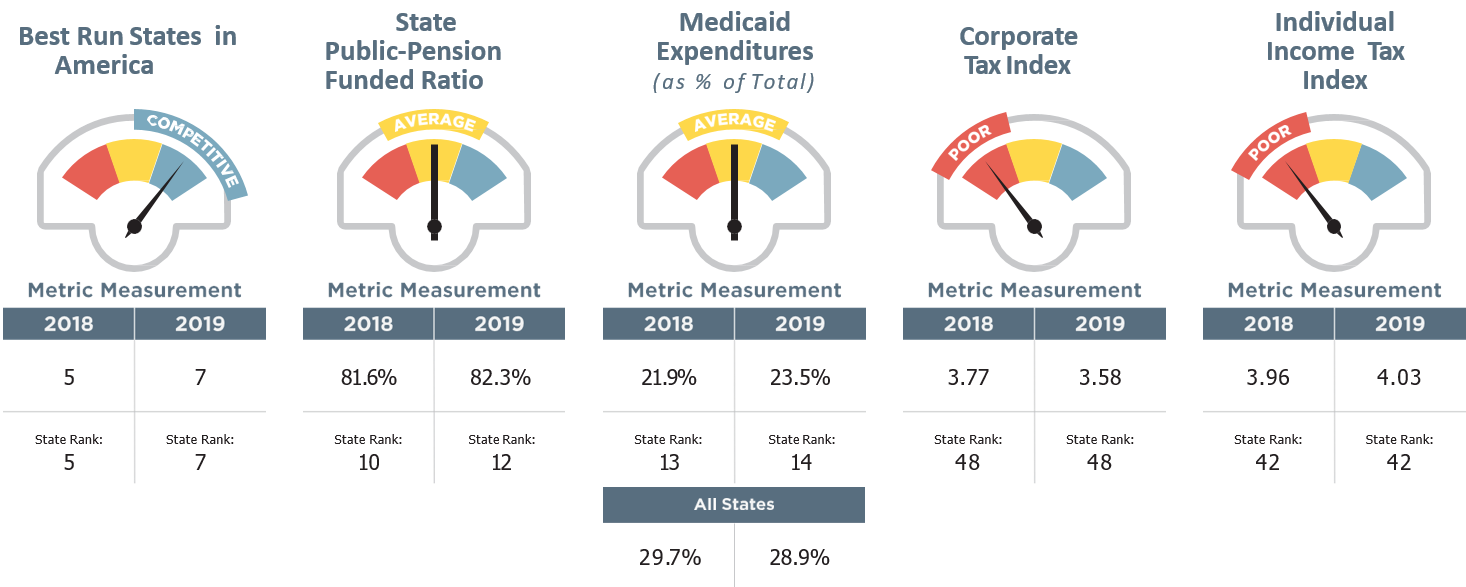Iowa's 2020 Competitive Dashboard
posted on Tuesday, March 10, 2020 in Economic Development

All data and information from Iowa Business Council Executive Director, Joe Murphy (pictured left)
Tuesday morning, March 10, Executive Director of the Iowa Business Council, Joe Murphy presented Iowa's Competitive Dashboard at the Hilton Garden Inn/Cedar Falls Event Center in Cedar Falls. Iowa's Competitive Dashboard is a nonpartisan review of the state’s economic climate, measuring Iowa’s progress in five categories relative to other states and serves as a tool to policymakers and business leaders in determining policies that will elevate Iowa's economy. The dashboard showed (picture below) that Iowa ranked in the middle of the pack for four of the five indicators – economic growth, education and workforce, governance, and health and wellness – while receiving a poor performance mark in the demographics and diversity category. For each category, Murphy presented what the IBC recommends to continue the positive momentum and addressing challenges to make the state more competitive.

Economic Growth
Despite geopolitical uncertainty, trade disputes, and volatile weather patterns, Iowa’s economy has remained steady, maintaining a $190 billion gross state product and increasing median household income by nearly $1,400 over last year. Ranking in the top 5 states for manufacturing value as a percent of gross state product, Iowa solidifies its reputation as an industrial capital. Iowa continues to rank high for labor force participation but paired with our consistently low unemployment rate, Iowa faces the persistent shortage of available workers for businesses to grow.

Recommended Actions:
- The availability of adequate housing for the overall labor market leads directly to a community’s ability to attract and retain a diverse and growing workforce.
- Increase investment to the State Housing Trust Fund and Workforce Housing Tax Credit programs. (HF 2163)
Education & Workforce
Iowa is ranked #1 in the country for the state’s average composite ACT score, tied with South Dakota. Moreover, Iowa ranks in the top 10 for the percentage of the population with a high school degree plus some level of post-secondary credential or degree.
However, Iowa has slipped 4% in both 8th grade reading and math proficiency, decreasing our ranking overall and pointing to challenges in educating the future workforce.

Recommended Actions:
- Business Education Alliance (BEA) will work with K-12 educational institutions to develop work-based learning opportunities for students.
- Continued work towards the 30,000 internships, externship and apprenticeship pledge by 2025.
- IBC will advocate for Future Ready Iowa to help upskill current workforce into high-demand jobs.
- Partner with institutions of higher education on workforce demands and trends.
Governance
Iowa ranks in the top 10 as a best-run state. Qualifying factors include Iowa’s low unemployment, high percentage of the population with access to health insurance, a triple A credit rating, and the high public-pension funded ratio. In fact, Iowa’s state public-pension ratio increased overall and is funded at 82.3%, well above the national average of 69.1%.
Though Iowa’s percentage of budget allocated to Medicaid increased this year, it remains less than the national average. The growing percentage of Medicaid expenditures must be taken into account as elected officials look to make funding decisions on other critical areas of Iowa government services. Iowa’s corporate and individual income taxes make it less competitive, though tax reforms of 2018 will likely positively affect these numbers once triggers are met.

Recommended Actions:
- The IBC supports the creation of a simple, transparent, and stable tax structure.
- The IBC will evaluate policy proposals and partner with organizations that look to build access to child care and mental health resources.
- HF 2203
- HF 2175
- SSB 3116
- HSB 657
Health & Wellness
Iowa decreased its percentage of obese individuals in the last year, highlighting the need to continue programs like the Healthiest State Initiative. While the number of smokers decreased in the past year, there is not yet data available on how vaping has affected the overall nicotine consumption in the state or country.
While the number of insured Iowans continues to be high, the state struggles to recruit and retain active primary care physicians. Additionally, Iowa’s rankings slipped in the Gallup National Health and Well-Being Index, which measures surveyed individuals’ overall well-being as it pertains to career, social, financial, community and physical status.

Recommended Actions:
- To accelerate the state’s positive momentum towards a healthy citizenry, it is critical the IBC continues its efforts to support the Healthiest State Initiative.
- The IBC supports efforts to attract and retain more primary care physicians as well as maximizing telehealth strategies to provide increased health care access across the state.
Demographics & Diversity
Iowa’s population growth has consistently trailed the national average and its net migration decreased by nearly 30 percent, over 1,000 people in the past year. Long-term prosperity will be constrained by a lack of people to fill jobs. Growing Iowa’s overall population will be critical to building the workforce pipeline and expanding state revenues. Iowa’s population growth continues to be outpaced by other states and still does not meet businesses’ growth needs.
Although Iowa’s ethnic diversity is increasing, with trends pointed toward consistent growth, Iowa ranks again in the bottom six states for the ethnic diversity of the population. Ultimately, the growth and diversification of Iowa’s population must be accelerated in both urban and rural communities to ensure continued economic growth for the state.

Recommended Actions:
- Modernize and reform the current immigration system to recruit and retain talent.
- Engage on innovative policy changes relating to licensing requirements, federally approved refugee resettlement opportunities, and immigration programs.